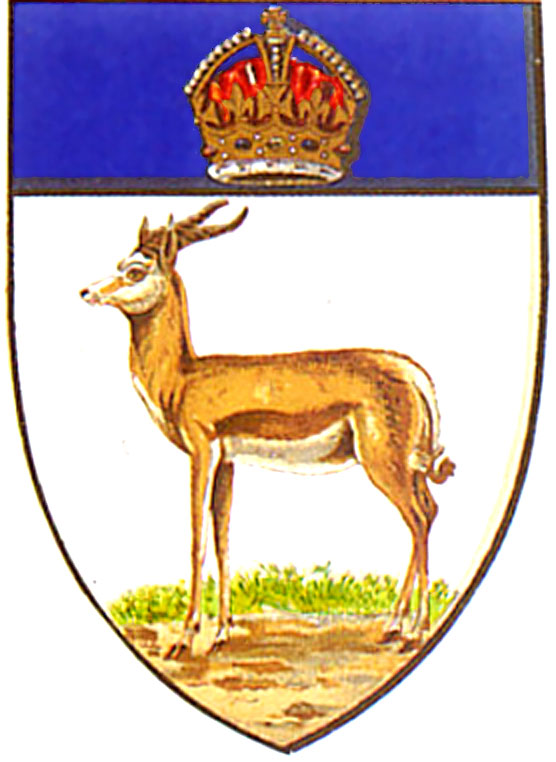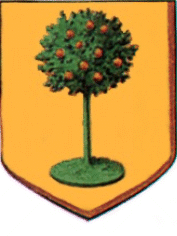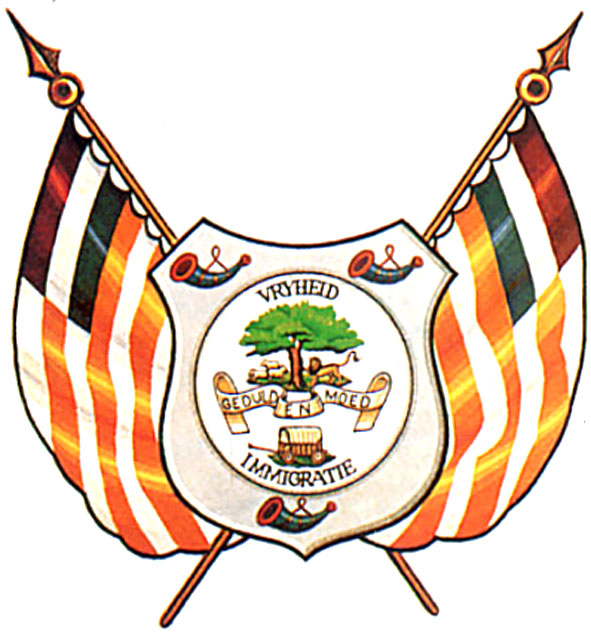

Orange Free State Province (often called Free State)
Provincie Oranje Vrij Staat

The Orange Free State Province continued to use the arms granted to the Orange River Colony by Royal Warrant on 10 December 1904, the blazon of which reads:
Arms: Argent on a Mound a Springbok and on a Chief Azure the Imperial crown all proper.
About the province:
The colony formally became a province of the Union of South Africa on 31 May 1910. Bloemfontein was proclaimed the judicial capital of the Union, and the province’s own legislature was called the Orange Free State Provincial Council. The administration was headed by an Administrator appointed by the Governor-General with the advice of the Prime Minister, assisted by an Executive Committee whose members had to be elected members of the Provincial Council.
Heraldic developments:
 Arms were granted to the province by the College of Arms on 4 May 1911, in the form of the Free State quarter of the Union arms, but the arms so granted were not even communicated to the province (see Union of South Africa) and, despite the technical invalidity of the 1904 grant, this continued in use.
Arms were granted to the province by the College of Arms on 4 May 1911, in the form of the Free State quarter of the Union arms, but the arms so granted were not even communicated to the province (see Union of South Africa) and, despite the technical invalidity of the 1904 grant, this continued in use.
In 1925 the arms of the Union replaced those of the Orange River Colony on the minutes of the Orange Free State Provincial Council.
Name of the province:
Since the Union’s official languages were English and Dutch, the province was also known as Oranje Vrij Staat. This was barely noticeably changed in 1925, when Afrikaans attained recognition, and the usual form eventually became Oranje Vrystaat (the letter Y replacing IJ, and it eventually being agreed to write “Vrystaat” as one word). Already in 1914 the province had acknowledged Afrikaans as a medium of instruction in schools.
Orange Free State Province (Free State)
Provinsie Oranje Vrystaat

Republican arms re-adopted:
State Herald F G Brownell writes that on 25 May 1937 the Orange Free State Provincial Council resolved that the arms of the Oranje Vrij Staat be officially recognised as the arms of the Province of the Orange Free State. The decision was forwarded to the Secretary of the Interior, who in reply pointed out the Royal Warrant of 1911. The Provincial Secretary responded that the Provincial Administration had no knowledge of the Royal Warrant and had not been consulted, and that the Executive Committee was not satisfied with the grant and would certainly not use the 1911 arms. A further letter added:
“. . . whilst the Provincial Ensigns designated to the Province in 1911 . . . may be regarded as a suitable quartering for use in the Union Coat of Arms, it is – whether regarded from an ćsthetic point, artistic, historical or any other point of view, most certainly neither desirable nor suitable as a Coat of Arms for use by the Province for Provincial purposes.”
Further letters merely reiterated the situation: the Free State was not prepared to accept any changes to the republican arms of 1856, and the Secretary for the Interior equally unprepared to submit these arms to the Crown for consideration. In this stalemate, the Free State authorities acted on their own and on 3 September 1937 the old republican arms appeared on the province’s Official Gazette.
Republican arms regularised:
“In 1950,” writes Brownell, “the Secretary for the Interior took up the question of provincial arms with the Prime Minister and each of the Provinces was asked to indicate which arms they desired to adopt. The Free State had reached their decision in 1937, and stuck to it. The Transvaal took a similar decision.”
Brownell next quotes a minute from the Secretary to the Prime Minister to the Secretary for the Interior, undated but clearly subsequent to the death of King George VI in 1952:
“The matter was submitted to Her Majesty the Queen, in accordance with the Prime Minister’s instructions, with the intimation that if formal approval could not be afforded to the Arms, namely, those of the Transvaal and the Orange Free State, which do not appear to conform to the laws of heraldry, without causing The Queen embarrassment and if Her Majesty would therefore prefer not to be associated with them, Ministers would not wish to take any further steps towards obtaining such formal approval. It was further intimated that in that event, Ministers proposed to seek Her Majesty’s approval for the withdrawal of the Royal Warrant of the 4th May 1911, and since it would be inappropriate to issue new Warrants in the case of the Cape and Natal Provinces only, to give informal permission to all Four the Provinces to use the arms which they respectively desire. “A reply has now been received from the Palace to the effect that Her Majesty will be glad to adopt the foregoing proposal whereby the Royal Warrant of the 4th May 1911, which granted certain Arms to the Provinces which they no longer desire, is withdrawn and informal permission simultaneously given to them to use the Coats of Arms which they desire to adopt. Her Majesty feels that it is right and proper that the choice of their Coats of Arms should rest with the Provinces themselves. In these circumstances a new Royal Warrant will not be sought. “Steps are being taken for the withdrawal of the above mentioned Warrant and you will be informed when formal approval therefor has been obtained.” In 1954 the Administrators of the four provinces were notified: “. . . Her Majesty the Queen has approved, formally, the withdrawal, with effect from the 22nd June, 1954, of the Royal Warrant of the 4th May 1911, in terms of which certain Coats of Arms were granted to the Provinces. Those Provinces which have not, as yet, done so, are now, at liberty to use the Coat of Arms which they desire to adopt.” Following the withdrawal of the Warrant of 1911, the Orange Free State applied to have its arms recorded in the College of Arms, which was done in July 1955. Following the promulgation of the Heraldry Act of 1962, the arms of the Orange Free State Province were registered with the State Herald under certificate of registration No 100, issued on 30 October 1967. Brownell does not quote a blazon from this certificate. Territorial and constitutional changes: Under the 1984 Constitution the Provincial Council was abolished. The Administrator, still a presidential appointee (the prerogative having passed to the State President in 1961), now co-opted his Executive Committee instead of drawing it from elected legislators. The ostensible aim of this change was to broaden the base of the provincial administration to include people of other races (only whites had been able to be members of the Provincial Council), but by and large those appointed were lackeys of President P W Botha. In 1994 the province was one of two that remained more or less the same as before. It reabsorbed the Thaba Nchu district and Witsieshoek, and became known formally as Free State Province. Comments, queries: Mike Oettle
Unlike the other three provinces of the Union, the Free State included tribal trust lands in only two magisterial districts: Thaba Nchu, where the inhabitants are Tswana-speaking, and Witsieshoek, which is Sotho-speaking. Thaba Nchu became part of the Tswana homeland, which took its “independence” as Bophuthatswana on 6 December 1977. Witsieshoek and Botshabelo, a newly constructed dormitory suburb outside Bloemfontein, became the non-independent homeland state of QwaQwa.
